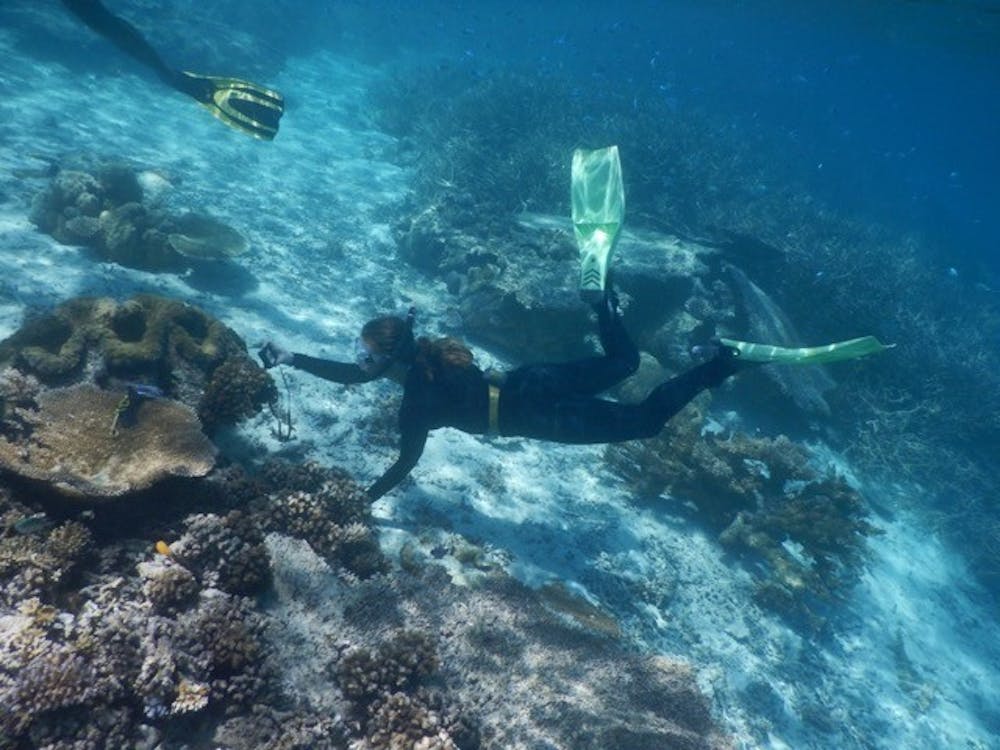
Courtesy of Allison Sweeney // Professor Allison Sweeney scuba dived in the island of Palau for her research on giant clams.
Scuba diving off tropical islands and exploring coral reefs for work sounds like some quixotic dream to most people, but for Physics professor Alison Sweeney, it’s anything but fantasy.
To Sweeney, the aquatic world is a lab unlike any other. A biologist by training but a professor in the Department of Physics and Astronomy, Sweeney is able to combine her love of both subjects through her research in marine biology about how sea creatures use physics in their day to day lives. By applying her research to real world problems, she creates a niche all her own here at Penn.
Before diving deep into research, Sweeney couldn’t imagine becoming a scientist.
“I didn’t know any scientists growing up. It wasn’t even clear to me that 'scientist' was a realistic job description. It seemed sort of like 'astronaut' or something that you might say you wanted to be when you were little but no one actually did,” Sweeney said.
Sweeney planned to enter her undergraduate studies majoring in biology and assumed that she would follow the typical pre-med path of many biology majors. However, upon arriving at Wesleyan University in 1993 she met her first professional scientists, her professors, who served as eye-opening mentors.
After taking an invertebrate zoology class, she was blown away by the diversity of life on earth and knew that marine biology was something worth studying. Although her love of biology was cemented early on, Sweeney didn’t take her first physics class until her junior year because of the structure of her major. But she was equally blown away by the subject and began to add in as many physics classes as possible, eventually looking for a graduate mentor who could help her combine her love of evolution and physics.
Her graduate advisor at Duke University, Sonke Johnsen, is in fact the one who encouraged her to learn to scuba dive to further her research.
Although Sweeney was hesitant at first and wondered if it was necessary, her mentor emphasized the importance of observing what one studies up close. Now, Sweeney totally agrees with his wisdom.
“Scuba diving, like anything else, is an observational tool for exploring the world,” Sweeney said. “There are directions that my work has gone that have been very important, and I never would have had those ideas or insights if I hadn’t been underwater seeing things for myself.”
Sweeney said that she and her team regularly go out in the water for projects around four times per year, and she currently has two funded projects involving snorkeling and scuba diving. One is on giant clams in the Pacific island, Palau, and another is on camouflage and self assembly of camouflage in open water, for which her team will go out on sea on research vessels.
After a weather-induced delay, Sweeney’s team is expected to venture out to sea sometime this spring.
Sweeney’s research on giant clams has received much acclaim and could lead to better solar panels. Unlike normal filter-feeding clams, giant clams from the Western Pacific farm algae inside their bodies, using light as energy. This allows them to use the light in the most efficient way possible, which Sweeney hopes to replicate in solar energy.
“This seems to be a strategy that gets you the most efficient possible use of sunlight per square meter of area and this is exactly the problem you need to solve in order to make something like biofuels or make gasoline from algae a viable economic process,” Sweeney said.
Sweeney is currently partnering with Penn professor Shu Yang from the School of Engineering and Applied Science to imitate the cells that clams use in this process. She said that since physicists may not know where to find biologically-based problems, her job is to bridge both fields.
“The University really put its money where its mouth is when it comes to bridging ideas between disciplines,” Sweeney said, “and in my opinion it makes Penn the most exciting place to be to be doing science right now.”
The Daily Pennsylvanian is an independent, student-run newspaper. Please consider making a donation to support the coverage that shapes the University. Your generosity ensures a future of strong journalism at Penn.
DonatePlease note All comments are eligible for publication in The Daily Pennsylvanian.





